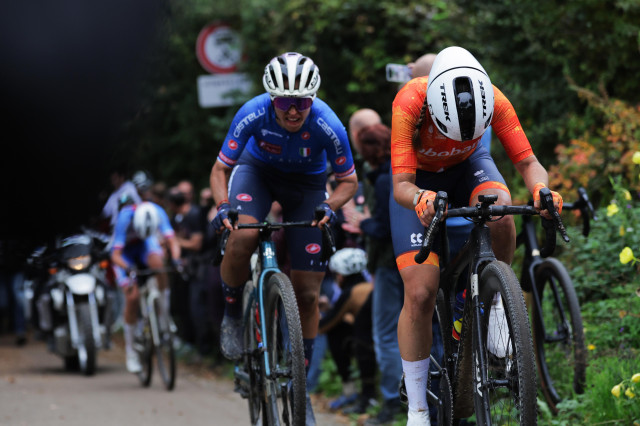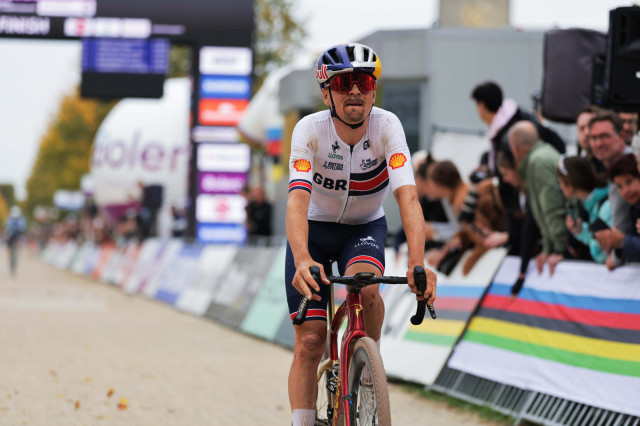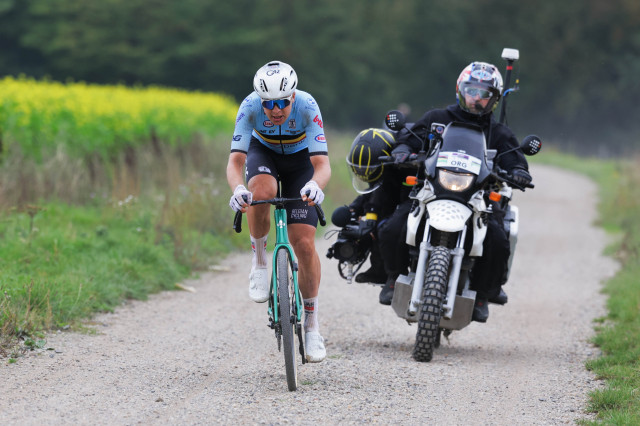[Photography by Alex Whitehead – SWpix]
Something of a clash of the titans from both road and gravel racing was expected on the farm roads and trails of the Zuid Limburg region in the Netherlands this weekend, as the best racers from both dropped bar disciplines, and a fair few mountain bikers too, joined many age groupers to battle for the official UCI Gravel World Championships titles. It would turn out to be a fast and tense weekend of racing, not least in the aftermath of the controversial tactics by the Dutch Women’s team, as we’ll explain and analyse below.
The elite women’s race
The first of the two official “big” UCI title races of the weekend was the elite women’s race, which took place in dry autumnal weather on Saturday, with just the odd patch of gloop and water along the way – although it was nothing that was going to really impact the way the race was ridden or the eventual results.
It was a deep and quality field for the race, although many of the anticipated big guns – such as past champions Kasia Niewiadoma, Pauline Ferrand-Prevot, and defending U23 champion Puck Peiterse did not take the start. This is perhaps understandable given their recent heavy race schedule.
Nonetheless, the greatest of them all – Mariane Vos of the Netherlands, the defending champion, and former gravel champs medallist and Dutch road racing powerhouse Lorena Wiebes were very much present and correct. This duo would ultimately sprint it out in Maastricht for the rainbow jersey, with Wiebes getting the best of Vos in the closing meters.

It has to be said, this was a fine piece of bike racing, which was completely dominated by the orange flush of the huge Dutch contingent, who placed seven riders in the top 10, and countless more backed up behind them.
For decades, the Dutch women have dominated elite road racing, and for this race, some of their biggest names weren’t even on the grid, which is amazing. Strangely, given that they are two of the strongest and most traditional cycling nations, there were just two Spanish and no French racers amongst the 103 finishers, which perhaps raises questions on how the championship status is perceived in some quarters.
The Dutch riders pretty much lined the whole race out from early on, with a few other nations breaking the over-stretched orange train throughout. The region of Limburg is one deeply rooted in cycling, and is home to the Amstel Gold classic road race, which weaves around these narrow and twisted farm roads with great windswept intensity – in one of the most, flat countries’ hilliest regions.
This is perfect terrain for the Dutch and Belgian riders, who grew up racing on such roads, err, and I guess that’s perhaps one of the confusing things about this race; although it was a great bike race, and was contested by the best in the game, it played out pretty much as a spring road classic, only with a few gravel caveats.
The terrain was rurally nice, and the kind of stuff that’s sweet to ride; fast, mildly hilly, pretty smooth, and on a mix of non-technical road-gravel & farm roads, which is definitely stretching some purists’ ideals of gravel racing.

2025 shirin van anrooij alex whitehead.jpg, by Liam Mercer
Perhaps even more confusing (and laced with undertones beyond the orange jerseys) was how the huge Dutch team raced in a tactical sense, which was frustrating to watch at times. It pretty much looked like it was a case of every woman for themselves, right up until the final 9km of the race, which only changed slightly once the riders could sense the finish was close. Even then, the solo Dutch leader Shirin van Anrooij was chased down inside the last kilometre by a group spearheaded by her national teammate Yara Kastelijn, seemingly to aid Wiebes’ win (though Kastelijn has since apologies to Van Anrooij, saying she regretted her tactics during the race).
There seemed to be very little national team cohesion involved, and perhaps more trade team loyalties (plus some riders are currently seeking contracts with bigger the bigger teams of the start next season) – although when Vos’s trade and national teammates chased her down it did question this too, and there were some questions raised by a couple of the Dutch riders after the race. This was an issue we picked up on last year, too, and it has to be noted that these are qualified individuals plus a few wild-card selections, not a traditionally selected national team.
Either way, it was a good race, and Vos’s tactical and technical mastery was on full display – perhaps this is the way gravel racing should be after all, or at least some of it?
The best of the Brits were Abi Smith in 15th place and Sophie Wright in 17th place.
Elite men
There were very few surprises when Sunday’s elite men’s race rolled out into the hazily bright back lanes of Limburg. In a near carbon copy of the 2025 race in nearby Belgian Brabant, and only missing the flying Dutchman Mathieu van der Poel, the Belgian “massive” were out in numbers. It would be fair to say the scene was much like the women’s race the day before, only the riders were wearing the blue Belgian jerseys, not the Dutch orange. The leading line was a virtual “blue wash”, only with a fair few more lone wolves thrown into the big blue mix.

Although this was a top dog field, there were perhaps fewer ‘big hitters’ than we’d seen in the past couple of years at the Championships. Many eyes were on Britain’s Tom Pidcock, who just 24 hours before had finished sixth in the Giro di Lombardia road monument race in Italy. The Yorkshire ace had also won the Amstel Gold in the area in the past, though he had no knowledge of the course, and was riding his first ever gravel race on a bike he’d never ridden before.
The Belgians did indeed dominate the front end of the race in numbers, and after rumbles over national/trade team tactics in last year’s race, and unlike in the women’s race the day before, there did seem to be a level of national team cohesion amongst them.

However, they certainly didn’t have the whole show to themselves, with former champ Matej Mohoric of Slovenia giving them a real run for their Belgian beer money. It turned out to be a far more attritional race than the woman’s race of the day before, and towards the end, former cyclo cross ace turned road pro, and twice silver medalist at the Gravel World, Froilan Vermeersch of Belgium, and Dutch XC/marathon MTB pro (and Dutch gravel champ), Frits Biesterbos rode off the front.

2025 florian vermeersch alex whitehead.jpg, by Liam Mercer
The duo never really looked to be in danger of being caught. Vermeersch looked a lot smoother and more in control and left the Dutchman behind in the hilly closing stages, coming in alone for an emotional, well-deserved, and unsurprising victory. Biesterbos held on for second, with Mohoric soloing in for bronze. Pidcock finished sixth on the day, as he had in Italy a day before. The next best Brit on the day was Connor Swift in 22nd place.
Our main takeaways
From the outside, this looked, once again, to be a very well organised and top quality weekend of racing, much like it was last year. Had the original agreed race dates and venue of Nice come through, no doubt the racing would have had a very different flavour, with more climbing, and perhaps more rough stuff – but that didn’t happen.
It’s a tough one to assess, because no matter who you throw into such a race, it’s almost always going to be the best versatile road pros who will come out on top; they are simply a WorldTour racing boosted engine step above most pure gravel and cross-country MTB riders.
The terrain, again – it’s hard to define, but arguably on this score the UCI series and Championship sits uneasily between rough classic road racing and what purists from the far side of the pond would consider true gravel to be – though, as a broadcast spectacle it works and is logistically attainable to cover, which is a huge part of it at this level.
As for the age groupers, it’s great to have an age group element to the event – but like last year, there were issues throughout with riders catching and trying to shimmy past slower riders, leaving some in hospital with broken bones.
As much as ‘racing’ with the pros is an attraction to age groupers, off-road bike racing isn’t as slow-paced or smooth as something like marathon running, and there are fundamental issues with the staggered start approach here. Maybe the racing should take place over a longer period to alleviate potential/probable issues?
You might also like:

